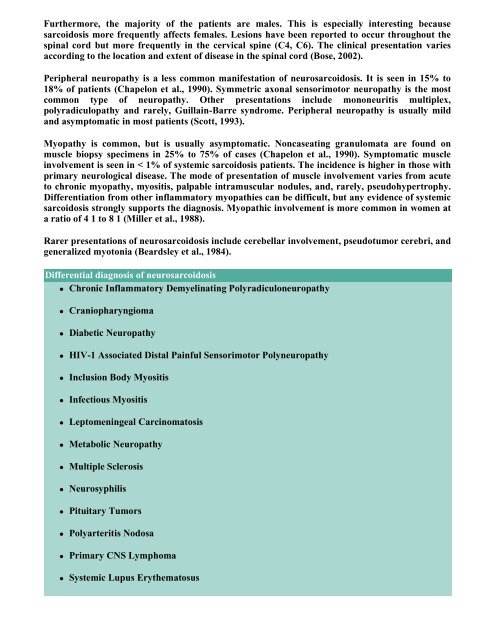INTRODUCTION Granulomatous inflammation is a distinctive ...
INTRODUCTION Granulomatous inflammation is a distinctive ...
INTRODUCTION Granulomatous inflammation is a distinctive ...
You also want an ePaper? Increase the reach of your titles
YUMPU automatically turns print PDFs into web optimized ePapers that Google loves.
Furthermore, the majority of the patients are males. Th<strong>is</strong> <strong>is</strong> especially interesting because<br />
sarcoidos<strong>is</strong> more frequently affects females. Lesions have been reported to occur throughout the<br />
spinal cord but more frequently in the cervical spine (C4, C6). The clinical presentation varies<br />
according to the location and extent of d<strong>is</strong>ease in the spinal cord (Bose, 2002).<br />
Peripheral neuropathy <strong>is</strong> a less common manifestation of neurosarcoidos<strong>is</strong>. It <strong>is</strong> seen in 15% to<br />
18% of patients (Chapelon et al., 1990). Symmetric axonal sensorimotor neuropathy <strong>is</strong> the most<br />
common type of neuropathy. Other presentations include mononeurit<strong>is</strong> multiplex,<br />
polyradiculopathy and rarely, Guillain-Barre syndrome. Peripheral neuropathy <strong>is</strong> usually mild<br />
and asymptomatic in most patients (Scott, 1993).<br />
Myopathy <strong>is</strong> common, but <strong>is</strong> usually asymptomatic. Noncaseating granulomata are found on<br />
muscle biopsy specimens in 25% to 75% of cases (Chapelon et al., 1990). Symptomatic muscle<br />
involvement <strong>is</strong> seen in < 1% of systemic sarcoidos<strong>is</strong> patients. The incidence <strong>is</strong> higher in those with<br />
primary neurological d<strong>is</strong>ease. The mode of presentation of muscle involvement varies from acute<br />
to chronic myopathy, myosit<strong>is</strong>, palpable intramuscular nodules, and, rarely, pseudohypertrophy.<br />
Differentiation from other inflammatory myopathies can be difficult, but any evidence of systemic<br />
sarcoidos<strong>is</strong> strongly supports the diagnos<strong>is</strong>. Myopathic involvement <strong>is</strong> more common in women at<br />
a ratio of 4 1 to 8 1 (Miller et al., 1988).<br />
Rarer presentations of neurosarcoidos<strong>is</strong> include cerebellar involvement, pseudotumor cerebri, and<br />
generalized myotonia (Beardsley et al., 1984).<br />
Differential diagnos<strong>is</strong> of neurosarcoidos<strong>is</strong><br />
Chronic Inflammatory Demyelinating Polyradiculoneuropathy<br />
Craniopharyngioma<br />
Diabetic Neuropathy<br />
HIV-1 Associated D<strong>is</strong>tal Painful Sensorimotor Polyneuropathy<br />
Inclusion Body Myosit<strong>is</strong><br />
Infectious Myosit<strong>is</strong><br />
Leptomeningeal Carcinomatos<strong>is</strong><br />
Metabolic Neuropathy<br />
Multiple Scleros<strong>is</strong><br />
Neurosyphil<strong>is</strong><br />
Pituitary Tumors<br />
Polyarterit<strong>is</strong> Nodosa<br />
Primary CNS Lymphoma<br />
Systemic Lupus Erythematosus


